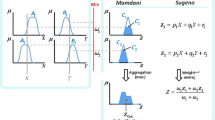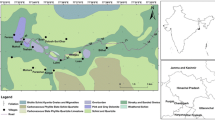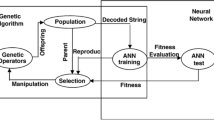Abstract
Physico-mechanical properties of rocks have great significance in all operational parts in mining activities, from exploration to final dispatch of material. Compressional wave velocity (p-wave velocity) and anisotropic behaviour of rocks are two such properties which help to understand the rock response under varying stress conditions. They also influence the breakage mechanism of rock. There are different methods to determine thep-wave velocity and anisotropyin situ and in the laboratory. These methods are cumbersome and time consuming. Fuzzy set theory, Fuzzy logic and Neural Networks techniques seem very well suited for typical geotechnical problems. In conjunction with statistics and conventional mathematical methods, hybrid methods can be developed that may prove to be a step forward in modeling geotechnical problems. Here, we have developed and compared two different models, Neuro-fuzzy systems (combination of fuzzy and artificial neural network systems) and Artificial neural network systems, for the prediction of compressional wave velocity.
Similar content being viewed by others
References
Alvarez Grima M, Bruines P A and Verhoef P N W 2000 Modeling tunnel boring machine performance by Neuro-fuzzy methods;J. Tunnelling and Underground Space Technology 15 259–269.
Aveline M 1964 Experimental results on the relation between micro-fissuration and speed of propagation of ultrasounds in the granites of Sidbore;J. Sci. Terre. 9 439–448.
Balakrishna S and Ramana Y V 1968 Integrated studies of the elastic properties of some Indian rocks;Geophysical monograph. AGU 12 489–500.
Berezkin V M and Mikhaylov I N 1964 On the correlational relationship between the density of rocks and their velocities of elastic wave propagation for the central and eastern regions of Russian platform, Geofiz;Razvedka 16 83–91.
Bezdek J C 1981 Pattern recognition with fuzzy objective function algorithms; New York: Plenum Press.
Chiu S 1994 Fuzzy model identification based on cluster estimation;J. Intelligent and fuzzy systems 3 267–278.
Diallo M S, Prasad M and Appel E 2003 Comparison between experimental results and theoretical predictions for p-wave velocity and attenuation at ultrasonic frequency;Wave motion 37 1–16.
Gaviglio P 1989 Longitudinal wave propagation in a limestone: the relationship between velocity and density;Rock Mech. and Rock Eng. 22 299–306.
Hogstrom K 1994 A study on strength parameter for aggregate from south western Sweden rocks; Res Rep. (Chamer Univ. of Technology, Goteborg, Sweden).
Inoue M and Ohomi M 1981 Relation between uniaxial compressive strength and elastic wave velocity of soft rock;Int. Conf. Weak Rock Tokyo 9–13.
Jang J S R, Suni C T and Mizutani E 1997 Neuro-fuzzy and soft computing: a computational approach to learning and machine intelligence; New York: Prentice Hall.
MacKay D J C 1992 Bayesian interpolation;Neural Comput. 4 415–447.
Maulenkamp F and Grima M A 1999 Application of neural networks for the prediction of the unconfined compressive strength (UCS) from Equotip hardness,J. Rock Mech. Min. Sci. 36 29–39.
Nauck D, Klawonn F and Kruse R 1997 Foundations of Neuro-fuzzy Systems; New York: John Wiley and Sons.
Singh T N, Monjezi M and Kumar D 1999 Static and dynamic properties of rocks at sub-zero temperature,Ind. Min. Engg. J. 27–31.
Singh T N and Dubey R K 2000 A study of transmission velocity of primary wave (p-wave) in coal measure sandstone,Ind. J. Sci. Ind. Res. 59 482–486.
Singh T N, Kanchan R, Saigal K and Verma A K 2004 Prediction of p-wave velocity and anisotropic properties of rock using artificial neural networks technique,J. Sci. and Ind. Res. 63 32–38.
Simpson P K 1990 Artificial neural system-foundation, paradigm, application and implementation; New York: Pergamon Press.
Takagi T and Sugeno M 1985 Fuzzy identification of systems and its applications to modeling and control;J. Transactions on systems, man, and cybernetics, SMC-15 116–132.
Volarovich M P and Vey-tsin Fan 1962 Investigation of the elastic properties of rocks by static and dynamic methods at high hydrostatic pressure;Akad Nauk SSSR Ins Fiz Zemli Tr. 23 19–24.
Yudborovsky I and Vilenskaya S M 1962 Some results of study of the elastic properties of rocks of western central Asia;Akad Nauk Turkmen SSR Ser Fiz-Tekh Khim Geol Nauk. 3 26–31.
Author information
Authors and Affiliations
Rights and permissions
About this article
Cite this article
Singh, T.N., Kanchan, R., Verma, A.K. et al. A comparative study of ANN and Neuro-fuzzy for the prediction of dynamic constant of rockmass. J Earth Syst Sci 114, 75–86 (2005). https://doi.org/10.1007/BF02702010
Received:
Accepted:
Issue Date:
DOI: https://doi.org/10.1007/BF02702010




